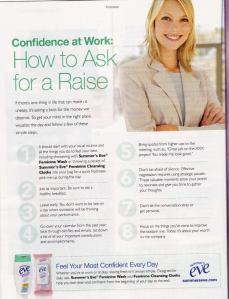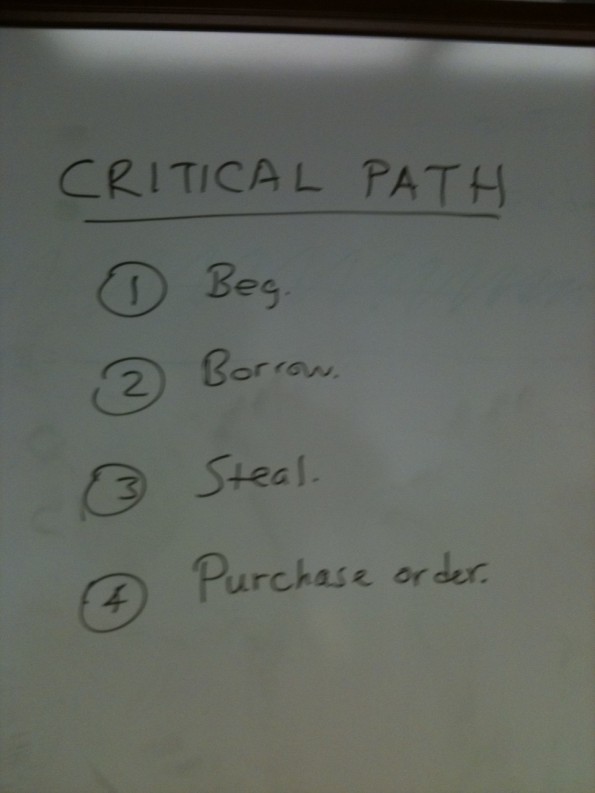The overlap between marketing and public relations
 In many of my bios, I say that I’ve been in marketing and PR for 15 years. My first real job was as a graphic production artist in the PR department of a labor union, and after that I became a marketing writer.
In many of my bios, I say that I’ve been in marketing and PR for 15 years. My first real job was as a graphic production artist in the PR department of a labor union, and after that I became a marketing writer.
In the last few months, however, I’ve had enormous difficulty defining where the line is between marketing and PR. A lot of what I’ve been asked to do as a marketing professional is within some official definitions of “public relations.” I write press releases, for example, and I have been the point of contact for industry analysts and have arranged meetings with industry reporters.
I have usually thought of the defining line as really going out and pushing for publicity, though. Yes, I can call a few of the analysts and reporters I know, but if you really want to make a push to get your product or service reviewed in a national or international publication, that’s not where my strengths are.
However, as I’ve been participating in PR chats on Twitter (#pr20chat and #solopr are two that I try to make every week), I’ve heard from PR professionals that they really don’t like defining themselves as publicists. This has really come to a head over the last couple of weeks when the New York Times let a business owner rant about PR, and several notable PR professionals responded to it (Kellye Crane’s great piece is here, and Gini Dietrich has a great piece here).
Which makes me feel dumb, since I’ve been using “PR” and “publicity” interchangeably, and, jeez, I even worked in a PR department. Unsurprisingly, the experts are vague about the definition of public relations. Grunig and Hunt (1984) define it as the management of communication between an organization and its “publics” (wow, I didn’t think that we were nouning adjectives until 1995!), but that covers advertising and marcom, two areas that are in the realm of marketing, not PR. Analyst relations, media relations, labor relations, and internal communications are other areas that are supposedly covered under the PR umbrella—but it still gets me wondering:
Where is the line between marketing and public relations? And if I don’t know where it is, having worked in the field(s) for over a decade, do both the marketing and PR industries need to reset customer expectations when starting projects?
The secret for successful startups’ go-to-market strategies
Many startup companies struggle with funding to get their products ready for prime time. In discussions with one of my clients, we developed a foolproof, critical path to market that I expect will revolutionize product planning and management for years to come.
You’re welcome.
Good info for Facebook privacy settings
Last night, I presented at the Sacramento Social Media Club’s “Relationships and Social Media” gathering. My section was on “Facebook Privacy Settings 101.” I listed some great articles and resources at the end of my presentation, and many of those attending wanted those URLs.
So without further ado, here they are:
- Mashable’s Facebook Privacy Guide: http://mashable.com/2011/02/07/facebook-privacy-guide/
- The 6 Things You Should Never Reveal on Facebook: http://finance.yahoo.com/family-home/article/110674/6-things-you-should-never-reveal-on-facebook
- Seven Things To Stop Doing Now on Facebook: http://finance.yahoo.com/family-home/article/109538/7-things-to-stop-doing-now-on-facebook
- The 3 Facebook Settings Every User Should Check: http://www.nytimes.com/external/readwriteweb/2010/01/20/20readwriteweb-the-3-facebook-settings-every-user-should-c-29287.html?em
- How to Go Completely Invisible on Facebook: http://www.businessinsider.com/facebook-privacy-
- settings-2011-1?slop=1
I had a great time and the event and I hope those in attendance found my presentation useful (and entertaining)! When the slideset is available, I’ll link to this as well.
Are you a sociopath? Become a Sprint customer!
 Sprint, according to Research and Markets, is expected to hemorrhage market share over the next five years. So Sprint—which does not have access to the iPhone—has decided to become aggressive in their pricing. Their current pricing promotion is that $69.99 gets you unlimited everything, while it only gets you voice calling with “the other guys.”
Sprint, according to Research and Markets, is expected to hemorrhage market share over the next five years. So Sprint—which does not have access to the iPhone—has decided to become aggressive in their pricing. Their current pricing promotion is that $69.99 gets you unlimited everything, while it only gets you voice calling with “the other guys.”
It’s an interesting promotion, because it goes directly after the smartphone power users that Verizon and AT&T have made their corporate money on over the last few years. But one of their advertising campaigns gets it all wrong.
In one ad, a sports doctor tells a severely injured football player that he shouldn’t worry: the video of the player getting injured, the changes to the doctor’s fantasy team, and the texts he’s sending are all included in Sprint’s monthly service. In another, a woman breaks up with her boyfriend while texting him at their table in the restaurant; she tells him it’s okay, because her Facebook updates (to single) and dating-site browsing is all included in Sprint’s monthly service.
This is intended to be funny, and it is, in a 30 Rock/The Office uncomfortable-humor kind of way. Many participants in online forums praise the spots’ humor, rightly calling out that it’s satire. And lo, much LOLing was had.
The problem is that Sprint wants the viewer to be a Sprint customer. And the Sprint customers in the commercials, as absurd and satirical as they are, are horrible human beings. They completely lack empathy for the people they’re with. They are nasty, clueless people. And Sprint is implying, through the ad, that they want the viewer to be just as horrible as their customers. This ad casts Sprint customers in a negative light; I suggest that in many viewers, it will provoke an emotional reaction in that they don’t want to be identified as Sprint customers. I certainly don’t want to be Dr. Douche.
Is this situation funny enough to save this commercial? Is there a way Sprint could have formulated this ad without implying that their customers are sociopaths?
If you are evil in this life, you come back as a marketing writer for Summer’s Eve.
 On Facebook recently, several of my friends have commented on an advertisement by Summer’s Eve that appeared in Woman’s Day magazine. Want to ask for a raise at work? Well, we’ve got a whole bunch of ideas to help you, says Summer’s Eve. And the #1 idea? Use our Summer’s Eve Feminine Wash–and don’t forget our Summer’s Eve Feminine Cleansing Cloths for that mid-day pick-me-up! (As Austin Powers says, it’s for giving your undercarriage a bit of a how’s-your-father.)
On Facebook recently, several of my friends have commented on an advertisement by Summer’s Eve that appeared in Woman’s Day magazine. Want to ask for a raise at work? Well, we’ve got a whole bunch of ideas to help you, says Summer’s Eve. And the #1 idea? Use our Summer’s Eve Feminine Wash–and don’t forget our Summer’s Eve Feminine Cleansing Cloths for that mid-day pick-me-up! (As Austin Powers says, it’s for giving your undercarriage a bit of a how’s-your-father.)
I’m not sure who exactly thought this was a good idea. Today’s woman most likely does not want to read an ad linking their value as an employee with how fresh-smelling their naughty bits are.
It’s easy to make fun of this ad. The ad says all the wrong things. The “tips” have very little thought put into them and are of little use to anyone who actually needs to ask for a raise. (Eat a good breakfast? Really?) And by placing the “wash your vajayjay” tip at #1, the ad is sending the message that Summer’s Eve has no interest in actually helping women get raises–they really only care about using this headline as a ruse to shill their product.
I think it would be difficult–excruciatingly, mind-numbingly difficult–to work in the marketing department for Summer’s Eve. Imagine, for a moment, that you are a marketing writer for Summer’s Eve. And the ad placement people come to you and say, “Hey, great news! We just got a good deal on a full-page ad in Woman’s Day! We’ve got to send it to graphics by the end of the week, so come up with a concept and copy by Thursday!”
If you’re a child of the eighties, like me, you know the phrase “Mom, do you ever have that–that ‘not-so-fresh’ feeling?” And as a child of the eighties, you were confused, and then, later, you realized what it meant, and then you chortled and made fun of it, and then changed the channel whenever the ads came on. But now, it’s 2010, and you’re working for Summer’s Eve, and you’re amazingly grateful to have a job in a down economy, and you look at the gaping maw of a blank page before you, and you think, “What horrible crime against humanity did I commit in a past life to have to come up with a full-page douche ad in 48 hours?”
Announcement: now blogging for Endeavors Technologies
Just a short note to tell y’all that I’m blogging for Endeavors Technologies for a bit. Endeavors has an application virtualization and streaming technology called Application Jukebox that I’m pretty impressed with. Using a client about the size of an IM app, it streams Windows apps to your desktop — and the app acts just like it would if it were locally installed.
![endeavorsLogo_fullcolor_onwhite[1]](https://sus4th.files.wordpress.com/2010/06/endeavorslogo_fullcolor_onwhite1.jpg?w=300&h=97) The thing that impresses me is that it handles Adobe Creative Suite apps perfectly. Illustrator, Photoshop, and InDesign activate within 90 seconds. (For those of you out there who are graphic designers, can you imagine installing Photoshop in a minute and a half?)
The thing that impresses me is that it handles Adobe Creative Suite apps perfectly. Illustrator, Photoshop, and InDesign activate within 90 seconds. (For those of you out there who are graphic designers, can you imagine installing Photoshop in a minute and a half?)
The technology is targeted toward a few different audiences: software vendors who’d like to offer their products as a service without re-engineering; distributors who want to offer a SaaS model and track usage; e-commerce providers who’d like to offer Windows software; and enterprise IT departments.
Disclaimer — they’re paying me to do some marketing work for them (although they didn’t pay me to write about them on my personal blog), but I like the management team and the technology a lot, and I hope to make them more successful in the marketplace. If you’ll be in Chicago next week, we’ll be at BriForum, booth 501.
The blog is here — I’m starting with the different types of application virtualization. Let me know what you think!
You have one product. How many brands should you have?
 Let’s say you work for a company that has one product. How many brands do you think you should have?
Let’s say you work for a company that has one product. How many brands do you think you should have?
When I phrase this question like this, it’s pretty obvious that the answer is “one.”
In reality, though, companies with one product rarely show a single brand to the public. They almost always show two brands: a company brand, and a product brand. And companies who do this can never answer why they’ve chosen to split their brand in two. The company is associated with the single product they sell; a single message, a single graphic idea, a single communication goal will help sell much more product than two messages, two ideas, and two goals.
Sometimes, companies get it right. In the late 1990’s, Claris Software had several products, but the development team behind one of their products, ClarisWorks, left the company. Claris decided that FileMaker, its database product, was the only product worth keeping, and changed the company name to — wait for it — FileMaker. (If Claris had been the stronger brand name, they could have changed the product name to Claris Database.)
There’s nothing wrong with having a company name and a separate product name. But promoting both names and brands is a waste of marketing effort and a waste of money. Your audience only has room in their collective brain to associate a concept with ONE thing — either your product brand or your company brand — not both. That’s just the way the human mind works.
Some marketing experts will say that you can have an umbrella brand, a main brand, and sub-brands. While it’s true that you can create a brand hierarchy, your audience will only remember one of those brands with a product (or product line).
Some companies defend themselves with the argument that they plan to release more products, and they want to leverage their company brand. Leveraging an existing brand seems easier than launching a new one. However, your audience has already made the decision to associate your first product with a certain brand; if they try to associate it with the second brand, it will weaken the branding for the first product–and probably won’t help the second product. There’s a reason why A-1 Poultry Sauce and Virgin Cola failed — and it doesn’t have anything to do with media outlets, marketing expenditures, or celebrity spokespeople. People simply didn’t trust the A-1 brand with chicken or the Virgin brand with soda.
Following this advice would lead you to create a house of brands (vs. a branded house — see more about that) should that second product get off the ground. I think a house of brands can be much stronger in the long run — and in the short run, your marketing budget (and your marketing department) will be grateful for your maniacal focus on a single brand.
“There’s no marketing worse than software marketing” — and how to fix it
 In 2008, I attended the Software Business Conference in San Jose. It was full of useful information on how to build effective pricing structures, what to plan for in the emerging software-as-a-service model, and how to protect company software from pirates. One thing I remember clearly is from one of the marketing presentations:
In 2008, I attended the Software Business Conference in San Jose. It was full of useful information on how to build effective pricing structures, what to plan for in the emerging software-as-a-service model, and how to protect company software from pirates. One thing I remember clearly is from one of the marketing presentations:
“There is no marketing worse than software marketing.”
Advertising for cars, shoes, irons, and soft drinks win awards. YouTube videos for minivans and waterproof running shoes go viral. Marketing campaigns for enterprise software? Most people think they just inspire afternoon naps.
So what’s the problem?
The first problem is that enterprise software is a complex animal, and that the features and benefits aren’t always easy to understand. Those who do understand it are often so entrenched in the industry that they use jargon to describe what the software does. The people assigned to market the software usually don’t understand the jargon, much less the product, without an awful lot of work.
It’s not surprising that many software vendors’ websites are confusing. When visiting these sites, it’s often very difficult to figure out what the software does, who the software is for, and what the real benefits are. Software often needs to be installed by people who have previous training in some technologies — and often, those people aren’t the same as the people who are making the purchasing decision. This adds a lot of moving parts onto the buying process, which adds complexity to the sales cycle, which complicates the marketing messages.
Branding goes extremely far in this industry. For IBM, HP, Oracle, or CA, software buyers know these companies and will often give them an audience. (“You don’t get fired for buying IBM,” as the saying went in the ’70s.) Smaller tech companies find it much harder to gain footing. And figuring out how to message to the target audience is daunting — many of them are techheads who say that they’re totally turned off by marketing.
So how do technology marketers meet this challenge?
Understand the market: First, marketers must talk to customers and developers. These people are on the front lines, using the product every day and shaping the product to meet certain goals. If marketers can get trained on the product–or at least sit in on a couple of days of training–they’ll be able to understand the product exponentially better.
Second, distill the product message down to one or two key benefits. “What does the product do?” is a question that must be answered in 10 words or fewer–both in your product descriptions and on your website. This product message might be similar to competitors’–but if the message is distilled, the product will seem simpler to customers (even the techies who say that they don’t pay attention to marketing). This can be one of the hardest things to do: developers and other stakeholders won’t want to kick out their favorite feature in the main marketing message. But study after study has shown that narrowing the focus of marketing messages increases revenue much more effectively than broadening the message.
Engage in conceptual conversations: Lastly, the company and/or the product experts must be willing to talk about issues and concepts in public forums: blogs, forums, and social media networks. When smart people at your company start talking about the way they view the world, it goes a long way towards convincing your prospects that they need to start viewing the world the same way. Your company people can’t look at this as a time to close a sale or hawking the latest 10% off promotion; rather, they have to genuinely want to engage prospects in conversations about the way technology is used to address business problems. If prospects realize that they really like the way your product/your smart people approach the problem, you’re 75% of the way to closing the sale.
These three things aren’t easy. They require many people in your organization to get out of their comfort zones. But technology buying has changed in the last five years: salespeople are running into more dead ends, where prospects who’ve seemed interested and have even viewed a demo are no longer returning their calls or responding to emails. The messages are getting filtered out and the prospects are being lost.
Advertising above the fray: an update
So Google got the name of their NexusOne phone in front of 100 million people in their target audience. They promised their online store would revolutionize the way smartphones were sold. News broke that Android phones surpassed the iPhone in sales for the first time ever.
And in the middle of all this, Google admitted defeat.
Now, selling 165,000 phones at almost $600 a pop in less than 6 months can hardly be called a failure. Creating revenue of $100M in half a year with no marketing but a webstore and a text ad on a search page is actually quite phenomenal. But even that $100M in revenue fell far short of Google’s own expectations.
But why did the NexusOne fail to hit the sales numbers of the iPhone and the Motorola Droid in that time?
Smartphone market experts think that people probably wanted to hold the phone in their hand at a store before they made the buying decision. While this makes a certain amount of intuitive sense, Apple sold a million iPads to people who couldn’t hold one before making the purchase.
I think that Google, in their rush to be innovative with marketing, ignored the marketing rule of 1+1=3. Running an 1/8-page ad 8 issues in a row has greater impact than a full page ad in a single publication. The iPhone and Droid both were advertised heavily on TV, billboards, magazines–as well as websites.
And the text for that ad on the Google search page? “Experience the NexusOne, the new Android phone from Google.”
There’s no compelling content in the ad line at all–no reason at all given by Google for a user to consider a NexusOne in the world of smartphones out there. (Except, possibly, that the phone is from Google, which smacks of arrogance.) The iPhone (“There’s an app for that”) and Droid (“In a world of doesn’t, Droid does”) are both about features, productivity, and being able to do everything you want on your smartphone.
It seems to me that Google ignored a few of the essential marketing fundamentals–they relied on a single medium to drive product awareness, and they failed to create a compelling story. Perhaps the “it’s from Google, it has to be good” works when your products–search and Chrome–are free, but the world changes when you now need a $600 investment from your customer base.
MLB, not McGwire, should get most of the blame for the steroid era
Today, a not-so-shocking confession came out that Mark McGwire used steroids off and on throughout his career. He confessed that he used steroids in 1998, when he hit 70 home runs, which shattering Roger Maris’ decades-old record.
Pundits, sportswriters, and columnists throughout the country have been discussing this confession. Some say it was time for McGwire to come clean; others that McGwire started the “Steroid Era.” But I haven’t seen any writer actually discuss the circumstances around it.
1994 was the year that Major League Baseball decided that the rich owners and the rich players weren’t rich enough, so they decided to ruin baseball for everyone. The work stoppage started on August 12, 1994, and forced the cancellation of the remainder of the 1994 season and the postseason. MLB was the first sport to lose an entire postseason due to a labor dispute. Afterwards, people were angry. Fans in Cincinnati paid for an airplane to tow a sign reading “Owners & Players: To hell with all of you!” Attendance and TV ratings fell dramatically. Some teams, like the Montreal Expos, never recovered.
Then came Mark McGwire.
In 1998, McGwire started hitting home runs. And hitting more home runs. Then a little known player on the Chicago Cubs, Sammy Sosa, started hitting home runs too. Soon they were both on pace to beat Maris’s record. And soon, they whole country was following the home run race, and forgetting that they had sworn on a stack of bibles never to attend another MLB game again. When McGwire smacked number 62, he circled the basepaths, then hugged Roger Maris’s family in the stands. TV shows cut away to the scene. America loved baseball again. All was forgiven.
A few years later, we begin to suspect that that year might be tainted. Soon, confessions of steroid use–and names of other users–come to light. At first, the confessors are laughed at; soon, however, their stories are found to hold water. But America doesn’t get angry. Some of us don’t want to believe that the players were juiced. Some of us tried to justify it, saying that the players are simply entertainers, and the steroid-fueled entertainment bring in the big bucks. But enough people were angry about it that Barry Bonds eclipsing Hank Aaron’s career record of 755 home runs was not celebrated like McGwire’s record; indeed, many people booed Bonds during his travels. But the fans kept coming, people kept their TVs on the game, and the revenues kept pouring in.
McGwire may have been the first, but he still saved baseball, and baseball owes him–not just for those 70 home runs, but for being a sacrificial lamb. Did MLB know the McGwire/Sosa roided-up race would be the start of an era marked by cheating and deception?
Did MLB care?

